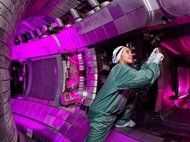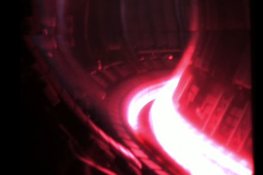Plasma Physics
As the name suggests, plasma physics concerns the physical properties of plasmas.
With increasing temperature, all materials are transformed successively from the solid, to liquid and then gaseous state. If the temperature is increased even more, a plasma is formed. Plasma is thus also described as the “fourth aggregate state of matter”: the gas atoms split into their constituent components – electrons and nuclei. Everyday examples of plasmas include plasma columns in neon tubes, electric sparks and the plasma filament in a lightning flash.
The properties of plasma are very different to those of a normal gas. For example, a plasma is electrically conductive; its motion can be influenced by electric and magnetic fields.
The fusion devices of the Max Planck Institute for Plasma Physics (IPP) in Garching (ASDEX Upgrade) and Greifswald (Wendelstein 7-X) exploit this particular property of plasma: they confine the hot plasma in a “magnetic field cage”.
Virtual walkthrough
The 360-degree panorama enables visitors a virtual walkthrough the Wendelstein 7-X fusion facility. A click of the mouse leads you into the middle of the plasma vessel, through the experiment hall and to the devices for microwave heating.
more
The 360-degree panorama tour takes you right into the heart of the facility – where 100 million degrees of hot plasmas are produced. The basement and attic of the facility as well as the control room from which the experiments are controlled are also accessible.
more
Fusion as an energy source
The Max Planck Institute for Plasma Physics (IPP) uses these devices to investigate the principles of a fusion power plant that would harness energy from the fusion of light atomic nuclei – just like the sun.
The aim here is to add to the range of efficient energy sources that could replace coal, oil and gas in the future: nuclear fusion is a third option along with nuclear fission in nuclear power plants and renewable energies, like wind and solar power.
The fusion of the hydrogen isotopes deuterium and tritium is the easiest form of fusion that can be achieved on Earth. The process generates a helium nucleus and a neutron is also released along with large volumes of usable energy. With fusion, one gram of combustible fuel could generate 90,000 kilowatt hours of energy in a power plant, which is equivalent to the combustion heat of eleven tonnes of coal.
Fusion fuels are inexpensive and evenly distributed throughout the world. Almost inexhaustible quantities of deuterium are available in seawater. Tritium – a radioactive gas with a short half-life of 12.3 years – only occurs in trace quantities in nature. However, it can be produced within the power plant from lithium, which is also available in abundance. Given that a fusion power plant could also offer favourable environmental and safety features, fusion could make a sustainable contribution to the world’s future energy supply.
You can find out about the current status of nuclear fusion and research findings on plasma physics here:
Cables and conduits, hoses and pipes surround this large apparatus like a cage.
more
The Joint European Torus generates 69 megajoules of energy from 0.2 milligrams of fuel - as much as is set free by burning two kilgrams of coal
more
Many publications by Max Planck scientists in 2022 were of great social relevance or met with a great media response. We have selected 12 articles to present you with an overview of some noteworthy research of the year
more
Julia Zimmermann talks about the foundation of the company terraplasma GmbH
more
European joint experiment prepares transition to large-scale ITER project
more
Through the integration of the IPP into the Max Planck Society, the Institute is opening a new chapter in its history, which goes back to Werner Heisenberg
more
On 21 March 1991, the Asdex Upgrade experimental facility at the Max Planck Institute for Plasma Physics in Garching generated the first plasma
more
Ionised molecules of air are being tested for the treatment of Covid-19 patients
more
Investigation of plasmas in astrophysics and fusion research / funding for another two to five years
more
Thomas Klinger, Director at the IPP, talks about the special features of the Wendelstein 7-X stellarator and its structure, and the prospects for the construction of a fusion power plant.
more
Show more
The Joint European Torus generates 69 megajoules of energy from 0.2 milligrams of fuel - as much as is set free by burning two kilgrams of coal
more
European joint experiment prepares transition to large-scale ITER project
more
Ionised molecules of air are being tested for the treatment of Covid-19 patients
more
Experimental operation of the fusion reactor type stellarator kicks off with festive ceremony
more
Official ceremony on February 3, 2016
more
In Greifswald, preparations are underway to put the world’s largest stellarator into operation
more
Invests millions to launch a US research programme on German device
more
Many publications by Max Planck scientists in 2022 were of great social relevance or met with a great media response. We have selected 12 articles to present you with an overview of some noteworthy research of the year
more
Julia Zimmermann talks about the foundation of the company terraplasma GmbH
more
Through the integration of the IPP into the Max Planck Society, the Institute is opening a new chapter in its history, which goes back to Werner Heisenberg
more
On 21 March 1991, the Asdex Upgrade experimental facility at the Max Planck Institute for Plasma Physics in Garching generated the first plasma
more
Investigation of plasmas in astrophysics and fusion research / funding for another two to five years
more
Thomas Klinger, Director at the IPP, talks about the special features of the Wendelstein 7-X stellarator and its structure, and the prospects for the construction of a fusion power plant.
more
Greifswald fusion device now in operation
more
Researchers produce plasmas in the laboratory, like the ones produced in the vicinity of black holes
more
















